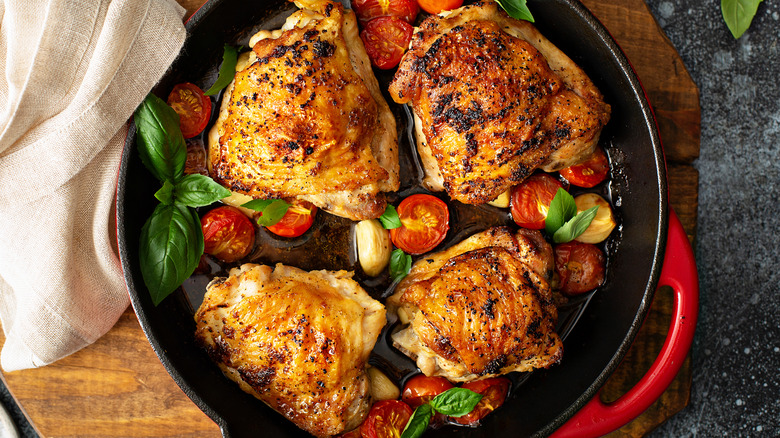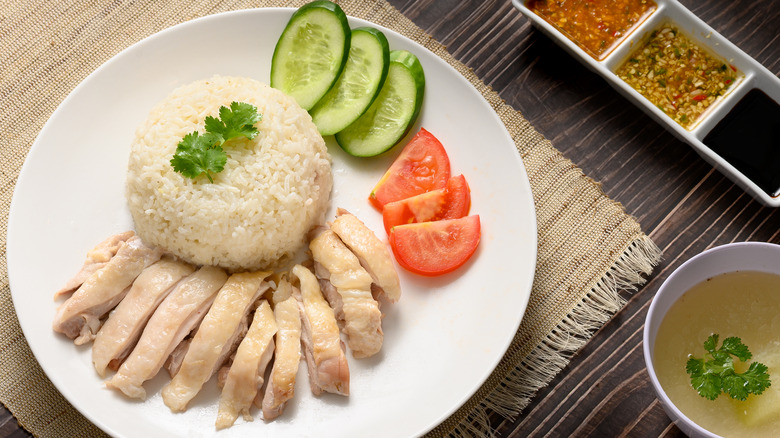Ina Garten's Secret To Juicy Chicken Is All About The Skin
When it comes to chicken, Ina Garten has you covered. Chicken is affordable, delicious, and the star of many Ina Garten recipes — a whole roast chicken is one of Jeffrey's favorite meals and made the list of "Jeffrey's All-Time Favorite Dinners" in her book "Cooking for Jeffrey." Garten's "Perfect Roast Chicken" is simply seasoned with salt and pepper (more than likely ground in Garten's old-fashioned pepper mill of choice), stuffed with fresh lemon, thyme sprigs, and a head of garlic, and nestled on top of Spanish onions. The whole bird is drizzled with melted butter and baked to perfection.
It is standard to bake a whole chicken with the skin on, of course — the skin turns a deep golden brown and has a crackly crisp texture — but Garten says you should leave the skin on no matter how you plan to cook it. Even if the recipe you're making requires skinless chicken, go ahead and remove the skin after cooking. Leaving the skin on doesn't just make the chicken tastier; it also helps retain moisture, yielding a more tender final product.
Why does leaving the skin on yield such good chicken?
Chicken skin holds fat, and fat equals flavor. It also helps the chicken hold onto more of the natural juices that are released in cooking. When roasting or grilling chicken, the skin melts as it cooks, which naturally drips down and bastes the chicken in fat. This is why when making something like crispy chicken thighs, you keep the skin side up. That's how it gets nice and crunchy.
Leaving the skin on is especially important for chicken breasts — they are leaner than dark meat chicken and have a real propensity to dry out. Maybe you are someone that has grown accustomed to boneless, skinless chicken breasts for health reasons. Even if you're considering your fat and calorie intake, it might still be worth leaving the skin on. According to a study by the National Broiler Council and published in the New England Journal of Medicine, the calorie and fat content of the chicken breast remains the same even when cooked with the skin on — the calorie conscious should remove the skin before eating. The difference is in flavor and moisture that the chicken breast retains due to the skin — the meat does not actually absorb all of that fat.
What about soggy chicken skin?
When crispy skin isn't what you are after, like in a soup, stew, or braise, the skin still adds flavor to the cooking liquid — the fat rendered from the skin flavors the whole dish. When poaching chicken for chicken salad, whipping up a pot of chicken soup, or making a comforting batch of chicken and dumplings, leave the skin on for the cooking process and remove it once it is cooked if you don't like the texture of boiled chicken skin.
However, chicken skin doesn't have to be crispy to be delectable. If you're skeptical, try making Hainanese chicken rice (海南鸡). The dish is most closely associated with places like Singapore, Malaysia, and Thailand, where it was brought by Chinese migrant workers from Hainan. Though the chicken may look blonde and bland, it is big in flavor.
A whole skin-on chicken is delicately poached in a scallion and ginger broth. The breast pieces of the chicken are actually just above the waterline in the pot, so they don't overcook. When the chicken is finished, the whole bird is dunked in an ice bath to stop cooking and improve the texture of the skin. It is served over rice that has been toasted in chicken fat and garlic and cooked in chicken broth. Serve the sliced chicken skin-on with punchy dark soy or chili garlic sauces, crisp sliced cucumbers, and a bowl of subtle chicken consomme. Trust Ina Garten, and leave the skin on!



